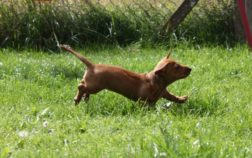Dachshunds, also known as sausage dogs, have always been adored for their unique body shape and lively personalities. But have you ever wondered if these small, charming canines are also protective of their owners? Well, the answer might surprise you. Despite their small stature, dachshunds possess an innate protective nature that runs deep within their DNA. From barking at potential threats to standing guard with unwavering loyalty, these pint-sized pooches have been known to fiercely defend their owners from any perceived danger. So, if you’re in search of a loving companion who will also double as your personal bodyguard, a dachshund might just be the four-legged friend for you.
Understanding Dachshund Temperament
Dachshunds are beloved and well-known for their unique appearance and playful personalities. However, alongside their charming qualities, they also possess inherent traits that make them protective companions. In this article, we will explore the various aspects of a Dachshund’s temperament, focusing specifically on their protective nature.
Dachshunds as loyal companions
Dachshunds are incredibly loyal and forge deep bonds with their owners. They have a strong desire to please and will go to great lengths to ensure their owners’ happiness and safety. This loyalty forms the basis of their protective instincts, as they are dedicated to keeping their loved ones out of harm’s way.
Independent nature of Dachshunds
Despite their loyalty, Dachshunds also have an independent streak. This independence can sometimes manifest in their protective behaviors, as they may take it upon themselves to guard their territory and loved ones. Their self-reliance often translates into a fearless determination to protect what they perceive as their responsibility.

Instinctual traits of Dachshunds
Dachshunds have a rich history as hunting dogs, and although their primary role has shifted to that of companion animals, their instinctual traits remain intact. These traits include an acute sense of smell, sharp hearing, and an unwavering determination. These instincts, combined with their loyalty and independence, contribute to their protectiveness.
Protectiveness in Dachshunds
Dachshunds have earned a reputation for being vigilant and protective dogs. Their innate desire to keep their loved ones safe is evident in their behavior towards potential threats.
Dachshunds as protective dogs
One of the prominent characteristics of Dachshunds is their protectiveness. They naturally assume the role of watchdogs and will alert their owners of any perceived danger. This protective instinct is deeply ingrained in their nature and is one of the reasons they make excellent guardians.
Attachment to their owners
Dachshunds form strong emotional attachments to their owners. They thrive on companionship and are known to develop a sense of responsibility for their family members. This attachment fuels their protectiveness, as they feel a deep sense of duty towards the welfare of their loved ones.

Recognizing potential threats
Dachshunds have a keen sense of awareness and are quick to pick up on cues that indicate potential threats. They remain vigilant and observant, always on the lookout for anything out of the ordinary. This ability to recognize potential dangers further reinforces their protective behavior.
Factors Influencing Dachshund’s Protectiveness
Several factors play a role in shaping a Dachshund’s protective instincts. These factors include genetic predisposition, socialization, training, and the owner’s behavior and relationship with their furry companion.
Genetic predisposition
Dachshunds possess certain genetic traits that contribute to their protectiveness. Their lineage as hunting dogs has imbued them with a natural instinct to guard and protect. However, it is important to note that the degree of protectiveness can vary from one Dachshund to another, as individual temperament can be influenced by genetic factors.
Socialization and training
Proper socialization and training are essential in nurturing a Dachshund’s protectiveness in a positive and controlled manner. Exposing them to various environments, people, and other animals from an early age helps them develop confidence and a sense of security. Training methods that focus on positive reinforcement rather than punishment further reinforce their protective behaviors.
Owner’s behavior and relationship
The owner’s behavior and relationship with their Dachshund play a crucial role in shaping their protectiveness. Building trust, providing consistent leadership, and establishing a bond of mutual respect are vital for fostering a healthy protective instinct. Owners who demonstrate responsible ownership and provide a secure environment can help their Dachshunds develop and exhibit appropriate protective behaviors.
Dachshunds vs. Other Breeds in Terms of Protectiveness
While Dachshunds are undoubtedly protective, it is essential to consider how they compare to other breeds in terms of their protectiveness.
Comparing protection instincts of different dog breeds
Different dog breeds exhibit varying degrees of protectiveness based on their temperament, breeding history, and intended roles. While some breeds are specifically bred for protection and guarding, such as German Shepherds or Rottweilers, Dachshunds have their own unique protective qualities.
Dachshunds’ reputation as watchdogs
Despite their small size, Dachshunds have gained a reputation as excellent watchdogs. Their acute senses and vigilant nature make them highly adept at alerting their owners of potential threats. While they may not possess the physical prowess of larger breeds, their determination and fearlessness make up for their compact size.
Notable protective traits of Dachshunds
Dachshunds possess several notable protective traits that set them apart from other breeds. Their unwavering loyalty, independence, and strong attachment to their owners drive their protectiveness. Additionally, their intelligence, tenacity, and keen instincts significantly contribute to their ability to guard and protect their loved ones.
Signs of Dachshund’s Protective Behavior
Understanding the signs that indicate a Dachshund’s protective behavior can help owners navigate and appreciate their furry companion’s natural instinct to keep them safe.
Barking and growling
One of the most recognizable signs of a Dachshund’s protectiveness is their propensity to bark and growl when they sense a potential threat. This vocalization serves as a warning to both the owner and the perceived intruder, highlighting the Dachshund’s protective nature.
Guarding behaviors
Dachshunds may exhibit guarding behaviors, such as standing in front of their owners, standing tall with raised hackles, or positioning themselves between their owners and potential threats. These actions demonstrate their determination to protect their loved ones and their territory.
Alertness towards strangers
A protective Dachshund will be highly alert and wary of strangers. They may display behaviors such as stiffening, intense staring, or maintaining a guarded posture. This heightened vigilance is a clear indication of their protective nature and their commitment to keeping their family safe.
Balancing Protectiveness and Aggression
While Dachshunds’ protectiveness is admirable, it is crucial to strike a balance between their protective instincts and aggression. As responsible owners, it is essential to manage their behavior and ensure they exhibit their protectiveness in a controlled manner.
Understanding the fine line between protectiveness and aggression
Protectiveness and aggression are distinct behaviors, and it is essential to understand the difference. Protectiveness is a natural instinct aimed at ensuring the safety of loved ones, while aggression is driven by hostility and a desire to harm. It is crucial to address any signs of aggression promptly and seek professional guidance if necessary.
Training techniques for managing behavior
Training plays a vital role in managing a Dachshund’s protective behavior. Positive reinforcement techniques, such as rewards and praise, can be used to reinforce desired behavior while discouraging any aggressive tendencies. Consistency and patience are key when training a Dachshund to strike the right balance between protectiveness and obedience.
Seeking professional help if necessary
In some cases, a Dachshund’s protectiveness may become problematic if it escalates into excessive aggression or uncontrollable behavior. If an owner is struggling to manage their Dachshund’s protective instincts, it is important to seek assistance from a professional dog trainer or behaviorist. These experts can provide guidance tailored to the individual dog’s needs, ensuring a harmonious relationship between the owner and their protective Dachshund.
Circumstances that Elicit Protective Behavior
A Dachshund’s protective behavior is often triggered by specific circumstances or situations where they feel the need to safeguard their loved ones.
Protectiveness towards family members
Dachshunds are most protective towards their immediate family members, as they have a strong emotional bond with them. They may display heightened vigilance and alertness when new people or animals enter their environment, ensuring the safety and well-being of their loved ones.
Protectiveness towards children
Dachshunds often exhibit a heightened sense of protectiveness when it comes to children. Their gentle and nurturing nature makes them particularly attentive to the well-being of young family members. However, it is important to supervise interactions between children and Dachshunds to ensure the safety of both parties.
Protectiveness in new environments
When placed in unfamiliar surroundings, Dachshunds may exhibit increased protectiveness as they feel the need to establish their territory and ensure the safety of their family. This behavior is driven by their instinct to protect their loved ones and their sense of responsibility towards their owners.
Tips for Enhancing Dachshund’s Protectiveness
For owners who wish to enhance their Dachshund’s protective instincts, there are several tips and techniques that can be implemented.
Socialization with other dogs and people
Proper socialization plays a crucial role in shaping a Dachshund’s protectiveness in a positive way. Introducing them to different dogs and people from an early age helps them distinguish between friends and potential threats, allowing them to develop a well-rounded protective instinct.
Positive reinforcement training methods
Training methods that focus on positive reinforcement are highly effective in enhancing a Dachshund’s protectiveness. Rewarding desired behavior with treats, praise, and affection reinforces their protective instincts while keeping aggression in check. Consistency and patience are key when implementing positive reinforcement techniques.
Creating a secure and stable environment
Providing a secure and stable environment is instrumental in nurturing a Dachshund’s protectiveness. Ensuring they have a comfortable space within the home, maintaining a consistent routine, and addressing any potential stressors or triggers can help them feel secure in their protective role. This supportive environment promotes a healthy expression of their protectiveness without causing undue anxiety or aggression.
Potential Challenges in Owning a Protective Dachshund
While owning a protective Dachshund can be incredibly rewarding, it is important to be aware of and address potential challenges that may arise.
Overprotectiveness leading to aggression
In some cases, a Dachshund’s overprotectiveness may escalate into aggressive behavior. It is crucial for owners to carefully manage their Dachshund’s protectiveness, ensuring it remains within appropriate boundaries. Seeking professional guidance can be beneficial in addressing any aggression concerns and fostering a balanced temperament.
Managing possessiveness towards food and toys
Protectiveness can extend beyond physical protection and manifest in possessiveness towards food, toys, or other resources. Owners must establish clear boundaries and provide consistent training to address possessive behaviors, preventing them from escalating into aggressive or resource-guarding tendencies.
Addressing separation anxiety
Dachshunds, due to their strong attachment to their owners and protective nature, may be prone to separation anxiety. This can lead to destructive behaviors or excessive barking when left alone. Implementing gradual desensitization techniques, providing mental and physical stimulation, and seeking professional assistance if needed can help address separation anxiety in a protective Dachshund.
Conclusion
Understanding the nuances of a Dachshund’s protectiveness is key to building a strong and harmonious relationship with these loyal companions. Their innate drive to keep their loved ones safe, combined with their unique temperament, makes them exceptional protective dogs. By embracing responsible ownership, providing proper training and socialization, and addressing any challenges that may arise, owners can fully enjoy the benefits of a protective Dachshund while nurturing a loving and secure bond with their four-legged friend.




